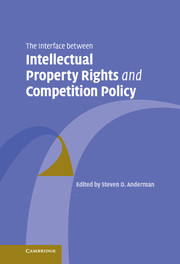Book contents
- Frontmatter
- Contents
- Notes on contributors
- Preface
- 1 The competition law/IP ‘interface’: an introductory note
- PART I Intellectual property rights and competition law in the major trading blocks
- PART II Intellectual property rights and competition law in smaller and medium sized open economies
- 5 Intellectual property rights and competition in Australia
- 6 Irish competition law and IP rights
- 7 The interface between intellectual property law and competition law in Singapore
- PART III Issues related to the interface between intellectual property rights and competition law
- Index
5 - Intellectual property rights and competition in Australia
Published online by Cambridge University Press: 27 July 2009
- Frontmatter
- Contents
- Notes on contributors
- Preface
- 1 The competition law/IP ‘interface’: an introductory note
- PART I Intellectual property rights and competition law in the major trading blocks
- PART II Intellectual property rights and competition law in smaller and medium sized open economies
- 5 Intellectual property rights and competition in Australia
- 6 Irish competition law and IP rights
- 7 The interface between intellectual property law and competition law in Singapore
- PART III Issues related to the interface between intellectual property rights and competition law
- Index
Summary
Provisions in intellectual property statutes
Introduction
Intellectual property rights, like all property, are a right to exclude. At a general level, competition concerns lie at the heart of the definition of any intellectual property right – the circumstances in which the law grants the right, the period for which the right endures, and the general scope of the right.
This chapter takes that generic trade-off for granted. It looks at the provisions in the various Australian intellectual property statutes that seem facially to reflect a specific concern that the scope of a property right or the way in which the right is exercised should be limited in the interests of competition. These include provisions for compulsory licensing, provisions that narrow the property right to excise a use or dealing so that it is not an infringement of the right (including parallel importation provisions), and provisions that affect the terms on which a right owner can license.
Australian IP law is in the process of change. A few years ago, the government commissioned an ad hoc committee, the Intellectual Property and Competition Review Committee (IPCRC), to review IP laws from the standpoint of competition. The Committee's report recommended some changes to the IP statutes. The Australian government has accepted some but not all of the Committee's recommendations. This account of Australian IP law includes a projection of where the law is headed.
Compulsory licensing
The Patents Act, the Copyright Act and the Designs Act all make provision for compulsory licensing.
- Type
- Chapter
- Information
- Publisher: Cambridge University PressPrint publication year: 2007
- 2
- Cited by



